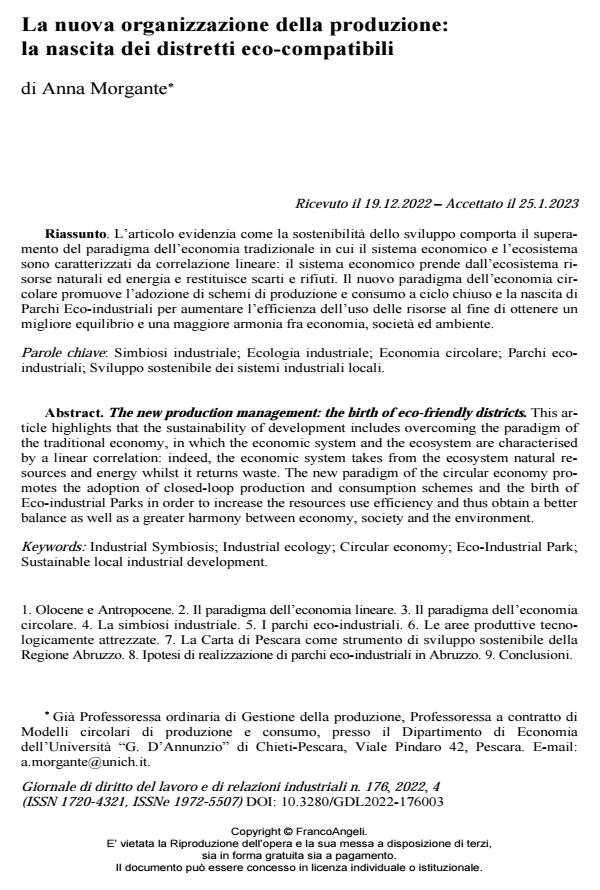The new production management: the birth of eco-friendly districts
Journal title GIORNALE DI DIRITTO DEL LAVORO E DI RELAZIONI INDUSTRIALI
Author/s Anna Morgante
Publishing Year 2023 Issue 2022/176 Language Italian
Pages 17 P. 555-571 File size 263 KB
DOI 10.3280/GDL2022-176003
DOI is like a bar code for intellectual property: to have more infomation
click here
Below, you can see the article first page
If you want to buy this article in PDF format, you can do it, following the instructions to buy download credits

FrancoAngeli is member of Publishers International Linking Association, Inc (PILA), a not-for-profit association which run the CrossRef service enabling links to and from online scholarly content.
This article highlights that the sustainability of development includes overcoming the paradigm of the traditional economy, in which the economic system and the ecosystem are characterised by a linear correlation: indeed, the economic system takes from the ecosystem natural re-sources and energy whilst it returns waste. The new paradigm of the circular economy pro-motes the adoption of closed-loop production and consumption schemes and the birth of Eco-industrial Parks in order to increase the resources use efficiency and thus obtain a better bal-ance as well as a greater harmony between economy, society and the environment.
Keywords: Industrial Symbiosis; Industrial ecology; Circular economy; Eco-Industrial Park; Sustainable local industrial development.
- Ayres R.U. (1989). Industrial Metabolism. TE: 23 ss.
- Bouilding K.E. (1966). The economics of the coming Spaceship Earth. In: Jarrett H., ed., Environmental Quality in a Growing Economy. Baltimore: Johns Hopkins University Press, 3 ss.
- Chertow M.R. (2000). Industrial symbiosis: literature and taxonomy. AREE, 25: 313 ss.
- Chertow M.R. (2009). Dynamics of geographically based industrial ecosystems. In: Ruth M., Davidsdottir B., eds., The Dynamics of Regions and Networks in industrial Ecosystems. Cheltenham: Edward Elgar Publishing, 6 ss.
- Commoner B. (1971). The Closing Cyrcle. A. Knopf Inc. (trad it. Il Cerchio da Chiudere, Milano: Garzanti, 1972).
- Crevoisier O., Jeannerat H. (2009). Territorial Knowledge Dynamics: from the proximity paradigm to multi-location milieus. EPS, 17: 1223 ss.
- Crutzen P.J. (2005). Benvenuti nell’Antropocene. Milano: Mondadori.
- Daly H.E. (1981). Lo Stato stazionario. L’economia dell’equilibrio biofisico e della crescita morale. Firenze: Sansoni.
- Deutz P., Gibbs D. (2008). Industrial Ecology and Regional Development: eco-industrial development as cluster policy. RS, 42: 1313 ss.
- Fleig A-K. (2000). Eco-Industrial Parks as a Strategy Towards Industrial Ecology in Developing and Newly Industrialised Countries. Report prepared for The Deutsche Gesellschaft für Technische.
- Geurgescu-Reagen N. (1976). Energy and Economic Miths. New York-Oxford: Pergamon Press (trad. it. Energia e Miti Economici. Torino: Bollati Boringhieri, 1982).
- Hawen P., Lowins A., Lowins Hunter L. (1999). Natural Capitalism. Creating the Next Industrial Re-volution. Boston, New York, London: Little Brown and Co. (trad. it. Il capitalismo naturale. La prossima rivoluzione industriale. Milano: Ed. Ambiente, 2001).
- Lowe E.A., Moran S.R., Holmes D.B. (1996). Fieldbook for the Development of Eco-industrial Park: Final Report. Research Triangle Park. NC: Research Triangle Institute.
- Lowe E.A., Geng Y. (2003). Industrial Ecology and Eco-Industrial Parks Handbook. Chinese edition published by Chemical Industries Press, Beijing.
- Moulaert F., Sekia F. (2003). Territorial innovation models. RS, 37: 289 ss.
- Pearce D.W., Turner R.K. (1991). Economia delle risorse naturali e dell’ambiente. Bologna: il Mulino.
- Roberts B.H. (2004). The application of industrial ecology principles and planning guidelines for the development of eco-industrial parks: an Australian case study. JCP, 12: 997 ss.
- Simboli A., Taddeo R., Morgante A. (2014). Analysing the development of Industrial Symbiosis in a motorcycle local industrial network: the role of contextual factors. JCP, 66: 372 ss.
- Simboli A., Taddeo R., Morgante A. (2015). The potential of Industrial Ecology in agri-food clusters (AFCs): a case study based on valorisation of auxiliary materials. EE, 111: 65 ss.
- Taddeo R., Simboli A., Morgante A. (2011). Symbiotic exchange and hazardous wastes in Chemical Industry. A Path-dependent case study. Proceeding of 21th SETAC Europe Annual Meeting. Milano, 28-29 maggio 2011.
- Taddeo R., Simboli A., Morgante A. (2012). Implementing eco-industrial park in existing cluster. Finding from a historical Italian chemical site. JCP, 33: 22 ss.
- Taddeo R., Simboli A., Ioppolo G., Morgante A. (2017). Industrial Symbiosis, networking and innovation: the potential role of Innovation Poles. Sustainability, 9: 1 ss.
- Taddeo R., Simboli A., Morgante A., Erkman S. (2017). The Development of Industrial Symbiosis in Existing Contexts. Experiences From Three Italian Clusters. EE, 139: 55 ss.
- Taddeo R., Morgante A., Lolli G., Simboli A., Raggi A. (2019). Politiche regionali di sviluppo ed economia circolare. Il caso della Regione Abruzzo. In: Fava F., a cura di, Green and Circular Economy: Ricerca, Innovazione e Nuove Opportunità. Santarcangelo di Romagna: Maggioli Editore, 176 ss.
Anna Morgante, La nuova organizzazione della produzione: la nascita dei distretti eco-compatibili in "GIORNALE DI DIRITTO DEL LAVORO E DI RELAZIONI INDUSTRIALI " 176/2022, pp 555-571, DOI: 10.3280/GDL2022-176003